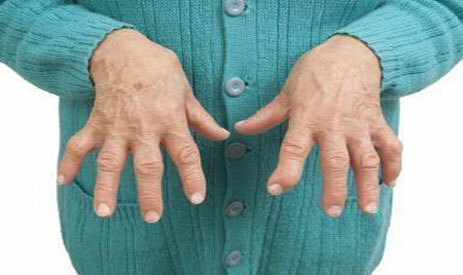The formation of the cone in the area of the head of the first toe of the metatarsus of the foot, in medicine is called Hallux( abduсto) valgus, the most common terminology denoting any deformation processes at the level of the metatarsal medial joint of the foot.
In its majority is accompanied by valgus - deformation of the 1st toe with a deviation in one direction.
Actually, in reality, this term reflects a complex pathology, the end result of which is expressed by a change in the direction of the 1st toe:
- the change in the anatomical position of the 1st metatarsal( tubular) bone, in the form of a deviation to the side;
- dislocation or subluxation of small unstable bones( sesamoid);
- weakening of the musculoskeletal structure and disturbance of its balance in the anterior part of the foot;
- omission of the longitudinal outer arch or internal;
- direct curvature of the finger.
The close anatomical interconnection of these structures, with the damage of at least one element from this chain, leads to a number of pathological changes. The treatment of such a pathology by the "grandmother's" recipes advertised on the Internet pages is nothing more than a myth. You can not independently cure articular and muscle-ligament deformity with lotions, conspiracies, eggs and all sorts of "labuda" that "experts from medicine" advise.
It is necessary to pass a survey, find out the extent of damage and the cause. Yes, with such a pathology, therapeutic methods for treating the stone on the big toe at home are used, but only at a certain stage of the disease - as a technique that prevents the further development of the disease. In the running processes, to eliminate the defect, there are many surgical methods.
Contents of
- 1 How does the "bone" develop?
- 2 Treatment of bones on the foot at home
- 3 What can Hallux valgus do with
How does the "bone" develop?
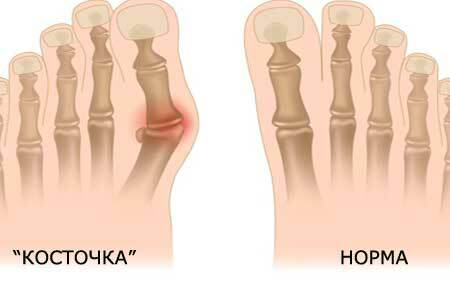
The direct cause of bulging of the metatarsal tubular bone is flat feet - congenital, or acquired under the influence of provocative factors. In this case, the depreciation functions of the foot are lost and, as a consequence, the center of gravity of the body shifts and there is an uneven redistribution of loads to certain areas of the musculoskeletal system, which are not calculated at all.
As a consequence of flatfoot develops a weakness of the ligamentous structures of the feet, which provoke subluxation or dislocation of the metatarsophalangeal joint. The weakened ligaments are not able to hold it in the anatomical position and the bone deflects, forming an external bulging, and the finger deflects in the direction of the "relatives".
If you do not remove the causative factor and do not take preventive measures, the radius of deflection will increase, the finger will creep into the neighboring ones, and cause them to deviate, while the bone on the finger will increase in size.
Joint deformation will be accompanied by:
- degenerative-inflammatory processes;
- with pain symptoms;
- proliferation of cartilaginous and bone tissue;
- limitation of joint mobility;
- sharp development of the ugly foot.
The development of ossicles on the metatarsophalangeal joint affects women. Not because many of them have a weakness for beautiful fashionable high-heeled shoes, as many believe.
By itself, a high heel and narrow sock contributes to the load on the legs, but if the owner of such shoes, feels comfortable in herself and she does not cause her any pain or fatigue - wear to health. But such loads on the feet should not have a prolonged effect.
This also applies to shoes with a perfectly flat sole. Permanent wearing leads to dystrophy of the foot( arch) of the foot on which the main emphasis is on walking, the ligaments and the base itself are too stretched, the foot is flattened and when walking it causes pain symptoms. Normally, the heel or wedge should not exceed 4 cm.
Sometimes, the nature of the development of bones can easily be established by carefully looking closely at the feet of the next of kin. Genes give us "gifts."The risk group includes people:
- with congenital deformities of the feet;
- with post-traumatic deformities;
- with acquired and congenital abnormalities of the ligament apparatus;
- patients with incorrect and inefficient nutrition, the completeness of which causes an additional burden on the legs;
- with a special professional activity( ballerinas, dancers).
Treating bone on the foot at home

Treating the bones on the big toe at home involves using conservative methods of official medicine used in the early stages of the disease. Elimination of all provocative factors and individually selected treatment will help to avoid process neglect and surgical intervention.
Bone treatment on the leg is complex and lasting, provides elimination of pathological deformity and correction of manifestations of pain symptoms. Due to the inclusion of several techniques. For the treatment to be successful, first of all, it is necessary to reduce the load on the feet.
With the help of dietotherapy and properly selected footwear:
- Selection of the right diet will help to exclude the development of joint inflammatory processes. The diet should not include fatty, spicy foods and spices, buns and dishes from legumes. Such a diet will help get rid of excess weight and, accordingly, reduce the load.
- The effect of the treatment depends largely on what kind of shoes the patient uses. Shoes should be comfortable and spacious, with a stable heel, not exceeding four centimeters. The nose of the shoe, preferably, should have a rounded configuration so that the fingers do not experience any pressure.
- Dense, flexible outsole to cushion well. If necessary, the doctor can appoint wearing orthopedic shoes or specialized insoles, which helps to eliminate flatfoot and reduce deforming processes, and sometimes causes the reverse development( regress) of the disease.
Strengthening the musculoskeletal system and bones
Massage procedures - relieve pain, help relax the feet, remove muscle tension, improve blood circulation, which contributes to the supply of tissues with nutrients.
Massage your feet yourself - rubbing, stroking, kneading, after saline baths for 10 - 15 minutes.
Complex of therapeutic exercises. Compiled by a professional and aimed at strengthening the ligament apparatus and correction of displaced bones. When treating the stone in the leg at home, it is possible to use simple complex exercises - alternating walking on socks, heels, straight and side walking on the outer and inner surfaces of the feet( 10-20 minutes).
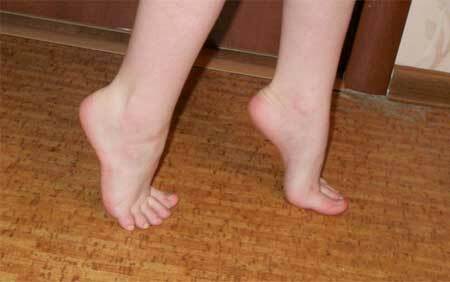
Methods of physiotherapy:
- paraffinotherapy and mud therapy;
- UHF and magnet therapy;
- electrophoresis and mud baths;
- acupuncture, laser and magnetic therapy;
- by electrostimulation;
- introduction of calcium, phosphorus and hydrocortisone into the body by electrophoresis and phonophoresis;
- shock wave therapy, used to eliminate cartilaginous growths.
Innovative methods include treatment with PRP( plasma injection of a patient enriched with platelets).This method accelerates the recovery process in bones, ligaments and joints.
- A great way to strengthen the foot, also nice - walking barefoot( on sand, pebbles or just on the ground).
The choice of orthopedic correction
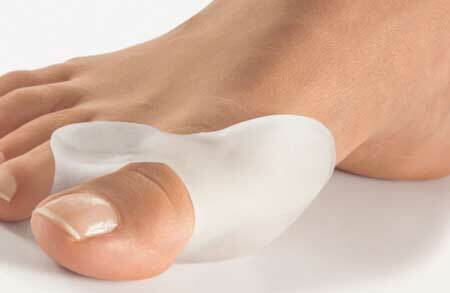
by the fixation of the bone of the big toe Photo
Conservative methods of orthopedic correction include:
- fixation of the finger in the anatomical position with corrective thumb splints;
- permanent wearing of orthopedic insoles, insteps and interdigital ridges, contributing to the uniform distribution of loads on the toe zone of the foot;
- use of screeds that support its transverse base;
- fixes the curved fingers in the correct position with corrective tie bands.
These devices are not used by themselves. Selection and rules of wearing are determined by the doctor, as some provide for a permanent sock( with flat feet), others dress only for the time of night sleep.
The task of all corrective devices is to create the most convenient and comfortable barrier between curved fingers and shoes and between the fingers themselves.
For example, insoles and arch supports help to create the physiological position of the foot( with curvature and flat feet), and finger correctors and rollers ensure the correct position of the thumbs of the limbs.
Pain and inflammation management
Medication therapy does not play a significant role in this pathology. Anesthetics and anti-inflammatory drugs are prescribed to eliminate inflammatory reactions and pain symptoms. They have a temporary effect and do not affect the progression of pathology.
Unfortunately, in advanced cases, individually selected methods of surgical intervention, their more than 400 types - open, closed, minimally invasive laser, on bones, tissues and ligaments.
It all depends on the degree of joint deformity and its cause. It would be desirable to notice, that surgical operations delete a pathology, but do not influence the reason of its development. This means that the main thing in treatment is to reduce the provocation factor to zero.
What can result from Hallux valgus
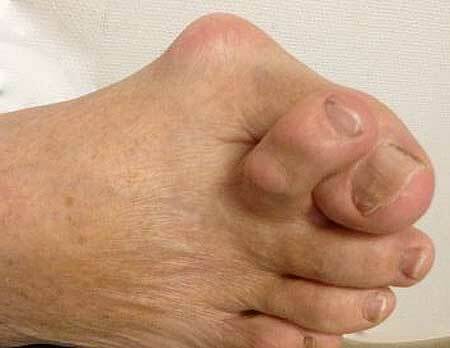
You need to get rid of the stone on your thumb anyway, since the development and neglect of the process can cause:
- Excessive deformation of the limbs;
- Development of metabolic cartilage fractures in hip and knee joints;
- Curvature of pelvic bones;
- Dystrophic processes in articular cartilage;
- Abnormal curvature of the spine;
- Development of herniated intervertebral discs;
- Manifestation of signs of discogenic radiculopathy.
Treatment of bones on the big toe at home is possible, only in the early stages of the dystrophic process. You can independently determine this, if you do not miss the :
- initial signs of a deviation towards the 1st toe;
- modifications of stop width and increase in the size of shoes;
- tenderness and discomfort of the feet at rest;
- signs of frequent neoplasm( calluses, warts);
- changing gait;
- formation of seals in the base area of the metatarsal bone of the 1st finger;
- slight curvature of the legs, and if you trample on one side.
Medical specialists determine the degree of valgus deformation by the angle of deviation. A mere mortal, it does not say anything, revealing at least one of the listed initial signs, says that the development process is gaining momentum and this is already an excuse for emergency treatment to the orthopedist.

